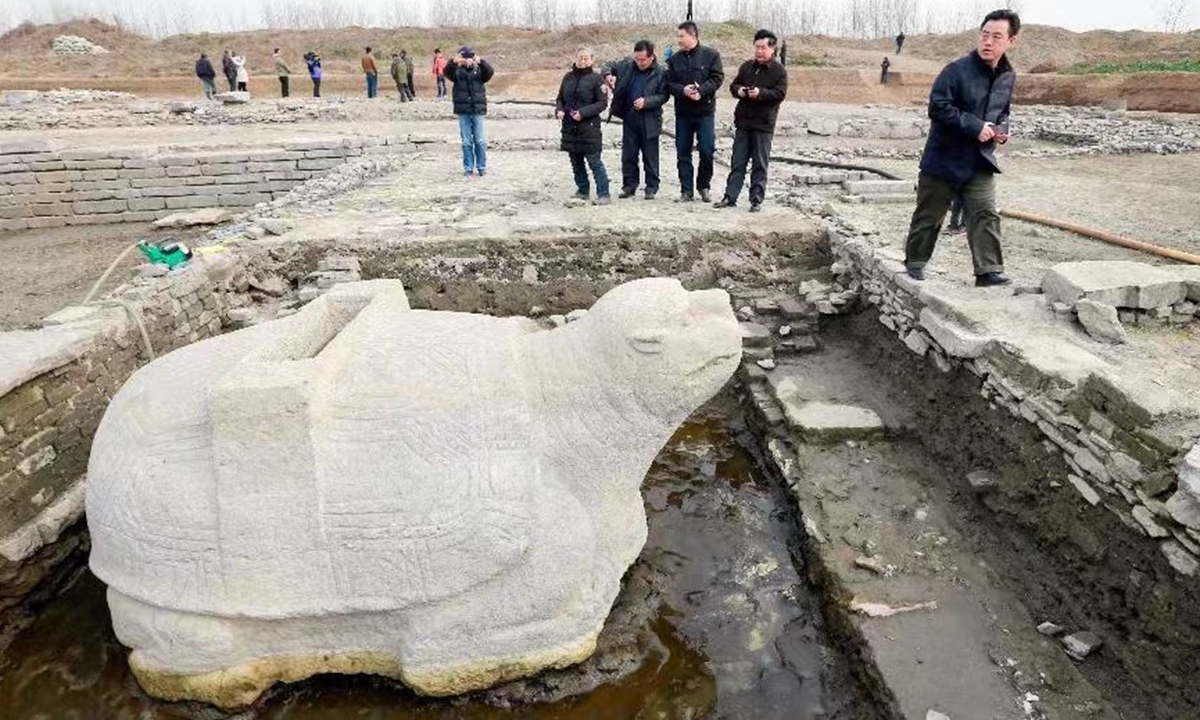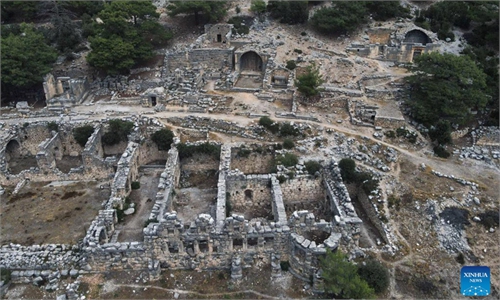ARTS / CULTURE & LEISURE
China’s ancient ‘Pompeii of the East’ Sizhou Ruins to open to public
An archaeological park and a museum will be built above a well-known ancient city ruins site in Xuyi, East China's Jiangsu Province, local officials announced on Sunday.
The Sizhou Ruins, currently an excavation site on a desolate island, used to be a populous city with an indispensable role as a waterway transport center in eastern China.

In China, it is also known as the "Pompeii of the East" as it was instantly destroyed by a heavy flood 300 years ago during the Qing Dynasty (1644-1911). It has remained buried under silt brought by the Yellow River.
"Now an important part of the Grand Canal National Cultural Park program, the archaeological park built upon the Sizhou Ruins will be among 22 main exhibition parks that help establish the Grand Canal Cultural Belt across China," Liang Jie, a Yangzhou-based Grand Canal expert, told the Global Times.
Built during the North Zhou (557-581) of China's Northern and Southern Dynasties (386-589), Sizhou was located along the Tongji Canal, four small canals that made up the Sui-Tang dynasties Grand Canal, a UNESCO World Heritage.
In 2012, a joint archaeological team composed of staff from museums in Nanjing, Xuzhou, Zhenjiang, Huai'an and other places excavated the Sizhou Ruins.
So far, five building foundations and one east-west main street in the city have been discovered. A section of the south city wall and a city gate have also been excavated.
The entire ancient city looks like a turtle, local archaeologists once explained.
Archaeologists also discovered three stone incense burners near a temple-like building ruins at the excavation site.
The inscriptions on the walls of the burners indicate that the incense burners were donated by Buddhist followers during the Zhengde period of the Ming Dynasty (1368-1644).
Many experts say that before this place vanished from the map, it was a major location for Buddhism back in ancient times.
"And in addition to a park and a museum, we are launching a string of culture and tourism programs here," noted Xuyi vice county head Chen Jun at Sunday's press conference, adding that about 6 billion yuan ($818 million) will be invested in making the plan come true.
This is not the country's first city to vanish in an instant during a disaster.
In Northwest China's Qinghai Province, the Lajia Ruins can be dated back to 4,000 years ago, when a local earthquake triggered a landslide, blocking the Yellow River and forming a huge barrier lake. As the lake suddenly burst its embankment, it carried a large amount of silt and instantly destroyed the town.
In 2000, archaeologists unearthed the remains of many humans, all of which died from non-natural causes. During the following excavations in 2002, experts found a terracotta bowl upside down on the ground containing noodles from more than 4,000 years ago. As the bowl was immediately buried in the sand after being turned upside down, a vacuum-like environment was created that preserved the food inside.
The Lajia Ruins opened to tourists as an archaeological park in 2020.
The Sizhou Ruins, currently an excavation site on a desolate island, used to be a populous city with an indispensable role as a waterway transport center in eastern China.

Stone tablet at the Si Zhou Ruins, East China's Jiangsu Province Photo: Screenshot from online
In China, it is also known as the "Pompeii of the East" as it was instantly destroyed by a heavy flood 300 years ago during the Qing Dynasty (1644-1911). It has remained buried under silt brought by the Yellow River.
"Now an important part of the Grand Canal National Cultural Park program, the archaeological park built upon the Sizhou Ruins will be among 22 main exhibition parks that help establish the Grand Canal Cultural Belt across China," Liang Jie, a Yangzhou-based Grand Canal expert, told the Global Times.
Built during the North Zhou (557-581) of China's Northern and Southern Dynasties (386-589), Sizhou was located along the Tongji Canal, four small canals that made up the Sui-Tang dynasties Grand Canal, a UNESCO World Heritage.
In 2012, a joint archaeological team composed of staff from museums in Nanjing, Xuzhou, Zhenjiang, Huai'an and other places excavated the Sizhou Ruins.
So far, five building foundations and one east-west main street in the city have been discovered. A section of the south city wall and a city gate have also been excavated.
The entire ancient city looks like a turtle, local archaeologists once explained.
Archaeologists also discovered three stone incense burners near a temple-like building ruins at the excavation site.
The inscriptions on the walls of the burners indicate that the incense burners were donated by Buddhist followers during the Zhengde period of the Ming Dynasty (1368-1644).
Many experts say that before this place vanished from the map, it was a major location for Buddhism back in ancient times.
"And in addition to a park and a museum, we are launching a string of culture and tourism programs here," noted Xuyi vice county head Chen Jun at Sunday's press conference, adding that about 6 billion yuan ($818 million) will be invested in making the plan come true.
This is not the country's first city to vanish in an instant during a disaster.
In Northwest China's Qinghai Province, the Lajia Ruins can be dated back to 4,000 years ago, when a local earthquake triggered a landslide, blocking the Yellow River and forming a huge barrier lake. As the lake suddenly burst its embankment, it carried a large amount of silt and instantly destroyed the town.
In 2000, archaeologists unearthed the remains of many humans, all of which died from non-natural causes. During the following excavations in 2002, experts found a terracotta bowl upside down on the ground containing noodles from more than 4,000 years ago. As the bowl was immediately buried in the sand after being turned upside down, a vacuum-like environment was created that preserved the food inside.
The Lajia Ruins opened to tourists as an archaeological park in 2020.

